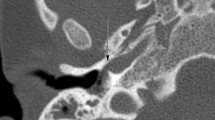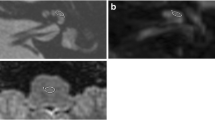Abstract
The temporal bone has a highly complex anatomical structure, in which the sensory organs of the cochlea and the vestibular system are contained within a small space together with the sound-conducting system of the middle ear. Detailed imaging is thus required in this anatomical area. There are a great many clinical aims for which the highest-possible spatial resolution is required. These include the localization of cerebrospinal fluid fistulas, the detection of malformations of the middle and inner ear and the vestibulocochlear nerve, an aberrant course of the facial nerve and anomalies of the arterial and venous structures, the confirmation of dehiscence of the semicircular canals and finally, the verification of endolymphatic hydrops in cases of Ménière’s disease. However, the term ‘high resolution’ is very time dependent. Two milestones in this respect have been (in 1991) the 3D visualization of the inner ear by means of maximum-intensity projection (MIP) of a T2-weighted constructive interference in steady state (CISS) sequence of a 1.5-tesla magnetic resonance imaging (MRI) scanner (Tanioka et al., Radiology 178:141–144, 1991) and (in 1997) imaging of the vestibulocochlear nerve for the diagnosis of hypoplasia inside the internal auditory canal using the same sequence (Casselman et al., Radiology 202:773–781, 1997).
The objective of this article is to highlight the options for, and the challenges of, contemporary imaging with regard to some clinical issues relating to the inner ear.





Similar content being viewed by others
References
Tanioka H, Shirakawa T, Machida T, Sasaki Y. Three-dimensional reconstructed MR imaging of the inner ear. Radiology. 1991;178:141–4.
Casselman JW, Offeciers FE, Govaerts PJ, Kuhweide R, Geldof H, Somers T, D’Hont G. Aplasia and hypoplasia of the vestibulocochlear nerve: diagnosis with MR imaging. Radiology. 1997;202:773–81.
Lane JI, Witte RJ, Henson OW, Driscoll CL, Camp J, Robb RA. Imaging microscopy of the middle and inner ear: Part II: MR microscopy. Clin Anat. 2005;18:409–15.
Lane JI, Witte RJ, Bolster B, Bernstein MA, Johnson K, Morris J. State of the art: 3 T imaging of the membranous labyrinth. AJNR Am J Neuroradiol. 2008;29:1436–40.
Silver RD, Djalilian HR, Levine SC, Rimell FL. High-resolution magnetic resonance imaging of human cochlea. Laryngoscope. 2002;112:1737–41.
Baloh RW, Honrubia V. Clinical neurophysiology of the vestibular system. 3rd Edn. New York: Oxford University Press; 2001. pp. 35–6.
Naganawa S, Suzuki K, Nakamichi R, Bokura K, Yoshida T, Sone M, Homann G, Nakashima T, Ikeda M. Semi-quantification of endolymphatic size on MR imaging after intravenous injection of single-dose gadodiamide: comparison between two types of processing strategies. Magn Reson Med Sci. 2013;12:261–9.
Giesemann AM, Kontorinis G, Jan Z, Lenarz T, Lanfermann H, Goetz F. The vestibulocochlear nerve: aplasia and hypoplasia in combination with inner ear malformations. Eur Radiol. 2012;22:519–24.
Sennaroglu L, Ziyal I. Auditory brainstem implantation. Auris Nasus Larynx. 39:439–50.
Lanson BG, Green JE, Roland JT Jr, Lalwani AK, Waltzman SB. Cochlear implantation in Children with CHARGE syndrome: therapeutic decisions and outcomes. Laryngoscope. 2007;117:1260–6.
Kang WS, Hyun SM, Lim HK, Shim BS, Cho JH, Lee KS. Normative diameters and effects of aging on the cochlear and facial nerves in normal-hearing Korean ears using 3.0-tesla magnetic resonance imaging. Laryngoscope. 2012;122:1109–14.
Jaryszak EM, Patel NA, Camp M, Mancuso AA, Antonelli PJ. Cochlear nerve diameter in normal hearing ears using high-resolution magnetic resonance imaging. Laryngoscope. 2009;119:2042–5.
Giesemann AM, Raab P, Lyutenski S, Dettmer S, Bültmann E, Frömke C, Lenarz T, Lanfermann H, Goetz F. Improved imaging of Cochlear nerve hypoplasia using a 3-tesla variable flip-angle turbo spin-echo sequence and a 7-cm surface coil. Laryngoscope. 2014;124:751–4.
Song MH, Kim SC, Kim J, Chang JW, Lee WS, Choi JY. The cochleovestibular nerve identified during auditory brainstem implantation in patients with narrow internal auditory canals: can preoperative evaluation predict cochleovestibular nerve deficiency? Laryngoscope. 2011;121:1773–9.
Kutz JW Jr, Lee KH, Isaacson B, Booth TN, Sweeney MH, Roland PS. Cochlear implantation in children with cochlear nerve absence or deficiency. Otol Neurotol. 2011;32:956–61.
Minor LB, Solomon D, Zinreich JS, Zee DS. Sound- and/or pressure-induced vertigo due to bone dehiscence of the superior semicircular canal. Arch Otolaryngol Head Neck Surg. 1998;124:249–58.
Russo JE, Crowson MG, DeAngelo EJ, Belden CJ, Saunders JE. Posterior semicircular canal dehiscence: CT prevalence and clinical symptoms. Otol Neurotol. 2014;35:310–4.
Tavassolie TS, Penninger RT, Zuniga MG, Minor LB, Carey JP. Multislice computed tomography in the diagnosis of superior canal dehiscence: how much error, and how to minimize it? Otol Neurotol. 2012;33:215–22.
Chien WW, Janky K, Minor LB, Carey JP. Superior canal dehiscence size: multivariate assessment of clinical impact. Otol Neurotol. 2012;33:810–5.
Lim ZM, Friedland PL, Boeddinghaus R, Thompson A, Rodrigues SJ, Atlas M. Otitic meningitis, superior semicircular canal dehiscence, and encephalocele: a case series. Otol Neurotol. 2012;33:610–2.
Manara R, Lionello M, de Filippis C, Citton V, Staffieri A, Marioni G. Superior semicircular canal dehiscence: a possible pathway for intracranial spread of infection. Am J Otolaryngol. 2012;33:263–5.
Hagiwara M, Shaikh JA, Fang Y, Fatterpekar G, Roehm PC. Prevalence of radiographic semicircular canal dehiscence in very young children: an evaluation using high-resolution computed tomography of the temporal bones. Pediatr Radiol. 2012;42:1456–64.
Nadgir RN, Ozonoff A, Devaiah AK, Halderman AA, Sakai O. Superior semicircular canal dehiscence: congenital or acquired condition? AJNR Am J Neuroradiol. 2011;32:947–9.
Browaeys P, Larson TL, Wong ML, Patel U. Can MRI replace CT in evaluating semicircular canal dehiscence? AJNR Am J Neuroradiol. 2013;34:1421–7.
Minor LB. Labyrinthine fistulae: pathobiology and management. Curr Opin Otolaryngol Head Neck Surg. 2003;11:340–6.
Gulya AJ, Schuknecht HF. Anatomy of the temporal bone with surgical implications. 3rd ed. New York: Informa Healthcare; 2007. pp. 162–5.
Helms J, Schwager K. Mittelohrmißbildungen. In: Helms J, editor. Oto-Rhino-Laryngologie in Klinik und Praxis, Band 1: Ohr. Stuttgart: Thieme Verlag; 1994. pp. 552–3.
Sone M, Mizuno T, Sugiura M, Naganawa S, Nakashima T. Three-dimensional fluid-attenuated inversion recovery magnetic resonance imaging investigation of inner ear disturbances in cases of middle ear cholesteatoma with labyrinthine fistula. Otol Neurotol. 2007;28:1029–33.
Algin O, Turkbey B. Intrathecal gadolinium-enhanced MR cisternography: a comprehensive review. AJNR Am J Neuroradiol. 2013;34:14–22.
Hallpike CS, Cairns H. Observations on the pathology of Meniere’s syndrome: (Section of otology). Proc R Soc Med. 1938;31:1317–36.
Foster CA, Breeze RE. Endolymphatic hydrops in Meniere’s disease: cause, consequence, or epiphenomenon? Otol Neurotol. 2013;34:1210–4.
Shibata T, Matsumoto S, Agishi T, Nagano T. Visualization of Reissner membrane and the spiral ganglion in human fetal cochlea by micro-computed tomography. Am J Otolaryngol. 2009;30:112–20.
Nakashima T, Naganawa S, Sugiura M, Teranishi M, Sone M, Hayashi H, Nakata S, Katayama N, Ishida IM. Visualization of endolymphatic hydrops in patients with Meniere’s disease. Laryngoscope. 2007;117:415–20.
Naganawa S, Yamazaki M, Kawai H, Bokura K, Sone M, Nakashima T. Imaging of endolymphatic and perilymphatic fluid after intravenous administration of single-dose gadodiamide. Magn Reson Med Sci. 2012;11:145–50.
Gürkov R, Berman A, Dietrich O, Flatz W, Jerin C, Krause E, Keeser D, Ertl-Wagner B. MR volumetric assessment of endolymphatic hydrops. Eur Radiol. 2015;25:585–95.
Naganawa S, Yamazaki M, Kawai H, Bokura K, Sone M, Nakashima T. Imaging of Meniere’s disease by subtraction of MR cisternography from positive perilymph image. Magn Reson Med Sci. 2012;11:303–9.
Author information
Authors and Affiliations
Corresponding author
Rights and permissions
About this article
Cite this article
Giesemann, A., Hofmann, E. Some Remarks on Imaging of the Inner Ear: Options and Limitations. Clin Neuroradiol 25 (Suppl 2), 197–203 (2015). https://doi.org/10.1007/s00062-015-0422-y
Received:
Accepted:
Published:
Issue Date:
DOI: https://doi.org/10.1007/s00062-015-0422-y




